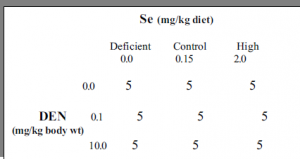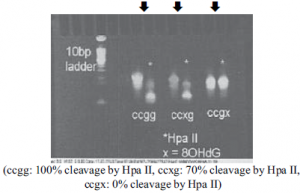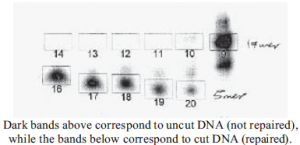Benjamin J. Wycherly and Dr. Merrill Christensen, Food Science and Nutrition
Highly reactive oxygen species produce DNA lesions, which are postulated to cause cancer. A particularly common lesion is that of an oxidized guanine residue, 8-hydroxyguanine (8-OHdG). This base is of particular concern because it can mispair with adenine during replication causing a mutation from G:C to A:T. This transversion is found frequently in human cancers.
The ability of selenium (Se) to reduce cancer incidence has prompted research to determine the mechanism or mechanisms by which selenium promotes this effect.1-2 My research sought to determine whether or not the level of dietary selenium affects the activity of the repair enzyme for 8-OH-dG, 8-oxoguanine DNA glycosylase (rOGG1).
Materials and Methods
Sprague Dawley rats (n=45) were fed 0.0. 0.15, and 2.0 mg Se/kg diet, (deficient, control, and high amounts of selenium) from March-May 1999. Nine hours before sacrifice the rats were injected with n-nitroso diethylamine (DEN), a pro-oxidant carcinogen in amounts of 0.0, 0.1, and 10.0 mg DEN/kg body weight. This 3 x 3 experimental design is shown below.
Livers were dissected and frozen at -80°C. Protein isolation of rOGG1 was performed at a later date, from October to December 2000. In order to determine the amount of rOGG1 activity in a given rat, a double-stranded oligonucleotide was obtained (shown below).
Incubation of this oligonucleotide with rOGG1 allows the oxidized guanine (g*) to be repaired and the DNA strand to be returned to normal. The bold type above indicates the recognition site for the restriction enzyme Hpa II which cleaves normal, double stranded DNA at the locations indicated by the marks ” ^ “. However, if the restriction site contains an 8-OH-dG residue at the g* position above, Hpa II is unable to cut the DNA.3 The arrows in the figure below indicate lanes that contain three different strands of DNA. The top bright bands correspond to uncut (17- mer) DNA, while the lower bands correspond to cut DNA (5-mer).
Because of this feature of Hpa II, the amount of DNA repair performed by rOGG1 can be determined by incubating a known quantity of the 8-OH-G oligonucleotide in crude nuclear extract from rat liver (which contains rOGG1). Then the oligonucleotide fragments are examined to see how much has been cut by separating them in a 20% polyacrylamide gel. Oligonucleotides were labeled on the 5’ end with the radionucleotide P32.
The densities of the bands were then quantified and analyzed using SAS statistical software under the direction of Dr. Dennis Eggert, Statistics Department, Brigham Young University. The statistical results yielded no significant difference between both selenium and DEN groups. Therefore, it appears that selenium causes no significant effect on the activity of the DNA repair enzyme rOGG1.
References
- Boiteux S., Radicella P., Base excision repair of 8-hydroxyguanine protects DNA from endogeneous oxidative stress, Biochimie. 81 (1999) 59-67.
- Stewart M.S., Cameron G.S., Antioxidant nutrients protect against UVB -induced oxidative damage to DNA of mouse keratinocytes in culture, J. Invest. Dermatol. 106 (1996) 1086-9.
- Turk P.W., Weitzman S.A., Free radical DNA adduct 8-OH-deoxyguanosine affects activity of Hpa II and Msp I restriction endonucleases, Free Rad. Res. 23 (1995) 255-258.



